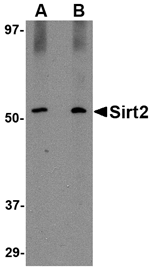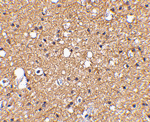The founding member of the sirtuin protein family was the silent information regulator 2 protein (Sir2p) of Saccharomyces cervisiae, an NAD+-dependent histone deacetylase (HDAC) that regulates chromatin silencing. The SIR2 family of genes are highly conserved from prokaryotes to eukaryotes. Mammals have seven homologs of Sir2p, SIRT1-7, which are involved in diverse processes ranging from transcriptional regulation, cell cycle progression and DNA-damage repair to aging. SIRT2 is a predominantly cytoplasmic protein that colocalizes with microtubules and can deacetylate alpha-tubulin and regulate progression through the cell cycle. Most Sirtuins are highly expressed in brain and testis, while Sirt2 expression is higher in fetal relative to adult brain. Recent studies on SIRT2 support the therapeutic utility of inhibitors for the treatment of neurodegenerative diseases such as Parkinson's disease.


